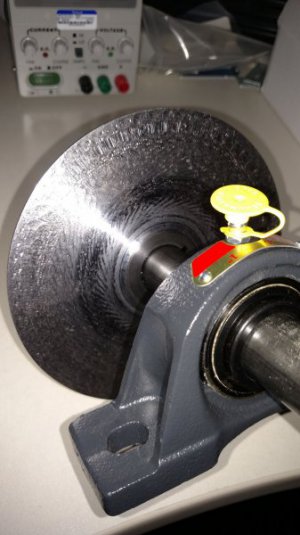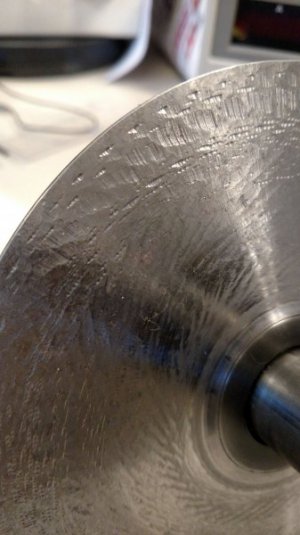I'm fabricating a desktop motor dynamometer to characterize automotive seat gear-motors.
It's basically a 1" solid steel shaft with the gear motor at one end, a shaft encoder at the other end, with a torque transducer and a brake in the middle. The whole shooting match is suspended on 4 bearings, a pair on either side of the torque transducer. With flex and solid couplers at the "appropriate" places. All sitting on 6" heavy aluminum channel for rigidity.
The object is to be able to "dial in" some repeatable and constant "drag" on the motor with the brake, while capturing torque and shaft-angle data from the transducer and encoder.
The first attempt at a suitable brake was a 6" diameter mechanical disc brake setup for a go-kart, actuated with a thumb wheel. The caliper is a big clunky affair that is free to "wallow" on its' "keeper" while finding it's own center. It offered little in the way of sensitivity and repeatability. The braking action was very unstable, and torque reading was all over the map.
I decided next to try a mechanical disk brake from a bicycle. Rather than fabricating a hub for the new disc, I tried to remove 0.050" from the 0.125" thickness of the go-kart disc on my new Grizzly 12x36 lathe, so it would fit in the new caliper. I failed miserably (see attached pics). The resulting finish is so rough it resembles the surface of an abrasive disc for a hand grinder.
I tried a couple different rpm's (360 & 600), and 2 different cutting tools, at least one being carbide. Taking cuts no deeper than 0.010" at a time.
While cutting the outer portion of the disc, it would chatter and sing like crazy. The closer to the hub the better it would cut, and it would peel off some nice curls. But at the out portions of the rotor it generate just small "chips" that came off like bullets.
I'm the first to admit I'm no machinist and am teaching myself as I go.
I know that disc rotors are turned all the time, which leaves me wondering why my feeble attempt at it turned out so bad.
Assumptions (perhaps mistaken) so far:
1. The outer portions of the disc is very hard and need special tooling.
2. The disc needs to be cut from both sides simultaneously, as I think they do on automotive brake rotors, to nullify resonance, and produce a better cut.
Is it possible to make such a cut on a lathe with good results?
Advice and post mortems gratefully received.


It's basically a 1" solid steel shaft with the gear motor at one end, a shaft encoder at the other end, with a torque transducer and a brake in the middle. The whole shooting match is suspended on 4 bearings, a pair on either side of the torque transducer. With flex and solid couplers at the "appropriate" places. All sitting on 6" heavy aluminum channel for rigidity.
The object is to be able to "dial in" some repeatable and constant "drag" on the motor with the brake, while capturing torque and shaft-angle data from the transducer and encoder.
The first attempt at a suitable brake was a 6" diameter mechanical disc brake setup for a go-kart, actuated with a thumb wheel. The caliper is a big clunky affair that is free to "wallow" on its' "keeper" while finding it's own center. It offered little in the way of sensitivity and repeatability. The braking action was very unstable, and torque reading was all over the map.
I decided next to try a mechanical disk brake from a bicycle. Rather than fabricating a hub for the new disc, I tried to remove 0.050" from the 0.125" thickness of the go-kart disc on my new Grizzly 12x36 lathe, so it would fit in the new caliper. I failed miserably (see attached pics). The resulting finish is so rough it resembles the surface of an abrasive disc for a hand grinder.
I tried a couple different rpm's (360 & 600), and 2 different cutting tools, at least one being carbide. Taking cuts no deeper than 0.010" at a time.
While cutting the outer portion of the disc, it would chatter and sing like crazy. The closer to the hub the better it would cut, and it would peel off some nice curls. But at the out portions of the rotor it generate just small "chips" that came off like bullets.
I'm the first to admit I'm no machinist and am teaching myself as I go.
I know that disc rotors are turned all the time, which leaves me wondering why my feeble attempt at it turned out so bad.
Assumptions (perhaps mistaken) so far:
1. The outer portions of the disc is very hard and need special tooling.
2. The disc needs to be cut from both sides simultaneously, as I think they do on automotive brake rotors, to nullify resonance, and produce a better cut.
Is it possible to make such a cut on a lathe with good results?
Advice and post mortems gratefully received.



